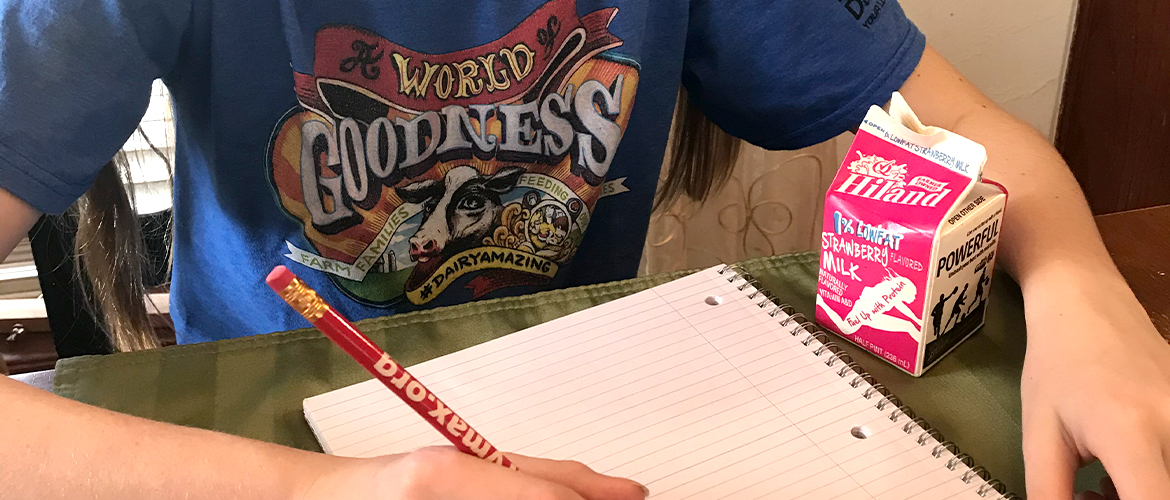Whether you’re looking to succeed in school, the real world or a career in STEM (science, technology, engineering and mathematics), math is an invaluable subject to master. Some people naturally excel in math and love it. And some, like me, need a little extra help to grasp the concepts. No matter which camp you or your kiddos fall into, using food and recipes is a great way to have fun and help your children understand several basic mathematical concepts.
Here are some great ways to work mathematical concepts into your kitchen and cook up some yummy homework.
Calculating Cost Per Serving: Milk
Normally, we buy milk by the gallon. But we don’t drink milk by the gallon (though sometimes it seems like we do); we drink it by the serving. Here is some math you can do with your kids to calculate cost per serving:
- On average, one gallon of milk costs $3.28
- One serving is 8 ounces, or one cup
- One gallon is 16 cups, or 16 servings
- $3.28/16 = $0.21 per serving
You can do this and compare to other beverages (like the cost of cow milk per serving versus alternative milks) or compare cost per serving from store to store.
Calculating Cost Per Serving: Recipes
Also, have your kids figure the cost per serving of a recipe. This process is used in school foodservice and restaurants to make sure that the price on the menu earns the restaurant enough money per serving to pay for raw ingredients as well as employee payroll, the restaurant’s electricity and other bills. Steps:
- Pick a recipe, like any one of these #DairyAmazing family favorites
- Write down each ingredient and how much is in the package purchased
- Write down the quantity of each ingredient needed to make the recipe
- If your kids are older, work with them to convert this quantity into a fraction or decimal of the total package. For instance, if you bought a dozen eggs, but only needed one egg, the quantity as a fraction would be 1/12 or 0.083. This is also an opportunity to teach about converting from ounces to tablespoons or teaspoons.
- Write down the cost of each ingredient then multiply that number by the quantity as a fraction
- You can use grocery apps or websites to find prices
- Add all of those prices together to get the total cost of the recipe
- Divide the total cost by the recipe’s number of servings
As an example, let’s apply these simple steps to this delicious Egg and Mozzarella Breakfast Pizza.
|
Item Needed |
Cost Total cost of ingredient purchased. |
Quantity Needed How much of each ingredient the recipe calls for. |
Quantity as a Fraction Quantity needed as a fraction of the package (represented in decimal form). |
Subtotal Cost multiplied by quantity needed. |
|
6-pack whole wheat English muffins |
$2.98 |
1 English muffin |
0.167 |
$0.50 |
|
8-ounce pack of mushrooms (about 10 mushrooms) |
$1.38 |
2 mushrooms |
0.2 |
$0.28 |
|
Bunch of green onions (about 10 stalks) |
$0.50 |
1 green onion |
0.1 |
$0.05 |
|
Green bell pepper |
$0.58 |
2 tablespoons diced pepper (about ¼ of the pepper) |
0.25 |
$0.15 |
|
18-pack carton eggs |
$1.89 |
2 eggs |
0.11 |
$0.21 |
|
3-ounce container black pepper |
$2.68 |
¼ teaspoon |
0.0069 |
$0.02 |
|
.95-ounce container Italian seasoning |
$0.98 |
A dash (about 1/8 teaspoon) |
0.029 |
$0.03 |
|
15-ounce jar pizza sauce |
$1.62 |
2 tablespoons (1 ounce) |
0.067 |
$0.11 |
|
8-ounce pack mozzarella cheese |
$2.29 |
½ cup (2 ounces) |
0.25 |
$0.57 |
|
RECIPE TOTAL |
$14.90 total investment |
|
|
$1.92 used in recipe |
The total investment of the Egg and Mozzarella Breakfast Pizza is $14.90 – but that includes plenty of leftover ingredients for future meals. The cost based on the amount of ingredients actually used in the recipe is about $1.92. The recipe’s serving size is two, leaving the price per serving at about 96 cents ($1.92/2 = 0.96).
You could compare that price to the price per serving from your favorite restaurant. To incorporate even more math, you can discuss ways your child could lower that cost, like shopping the pantry for ingredients you already have – such as seasoning and eggs – or selecting cheaper brands and using coupons.
Working on math AND getting food on the table, now that’s a win-win! Find more #DairyAmazing recipes.




